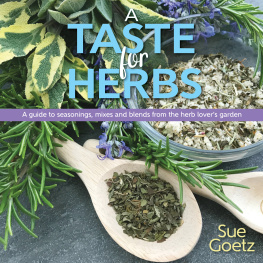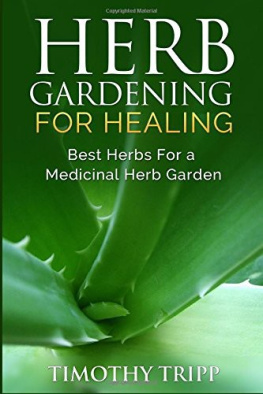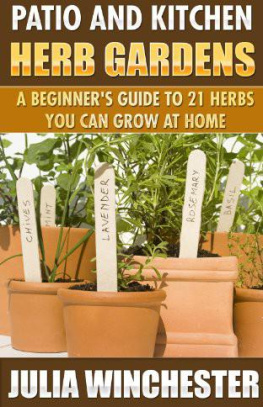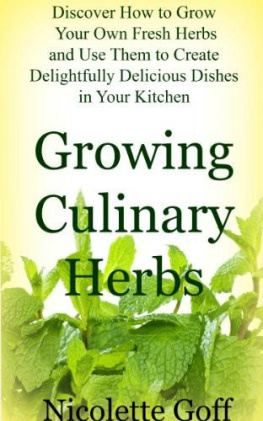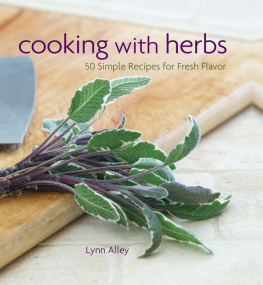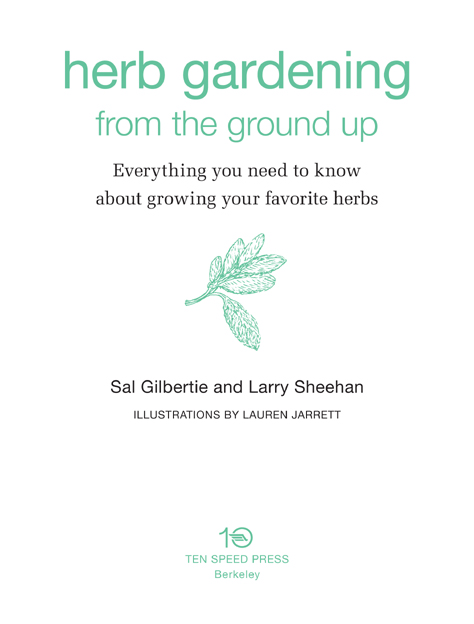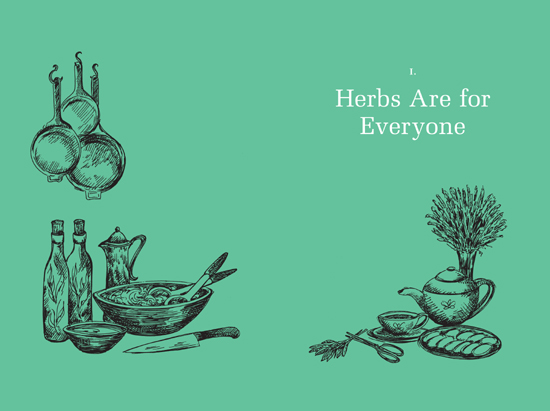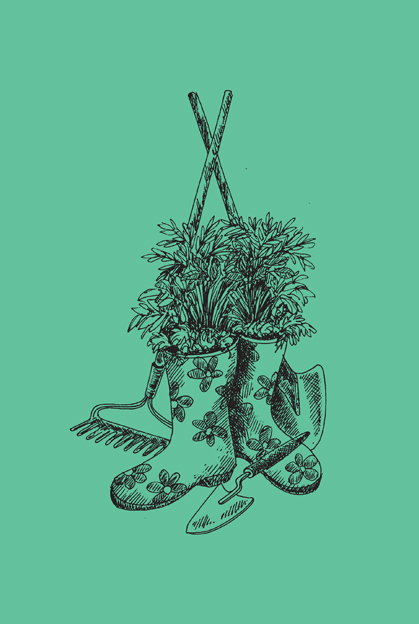
Copyright 2012 by Sal Gilbertie and Larry Sheehan
Illustrations 2012 by Lauren Jarrett
All rights reserved.
This is a revised edition, with new illustrations, of a work originally published in the United States as Herb Gardening at Its Best by Atheneum Publishers in 1978.
Published in the United States by Ten Speed Press, an imprint of the Crown Publishing Group, a division of Random House, Inc., New York.
www.crownpublishing.com
www.tenspeed.com
Ten Speed Press and the Ten Speed Press colophon are registered trademarks
of Random House, Inc.
Library of Congress Cataloging-in-Publication Data
Gilbertie, Sal.
Herb gardening from the ground up : everything you need to know about growing your favorite herbs / Sal Gilbertie and Larry Sheehan. 1st ed.
p. cm.
Includes index.
1. Herb gardening. 2. Herb gardens. I. Sheehan, Larry. II. Title. III. Title: Everything you need to know about growing your favorite herbs.
SB351.H5G545 2012
635.7dc23
2011027436
eISBN: 978-1-60774-080-3
Cover by Katy Brown
Cover photographs Rachel Weill/Media Bakery (right) and Ron Levine/Media Bakery (left)
v3.1
For Giovanni de Bernardone, who taught me
to thank God every day for the
wondrous gift of herbs.
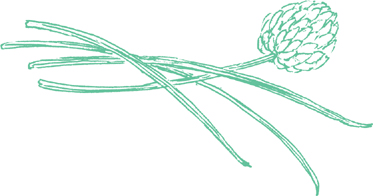
CONTENTS
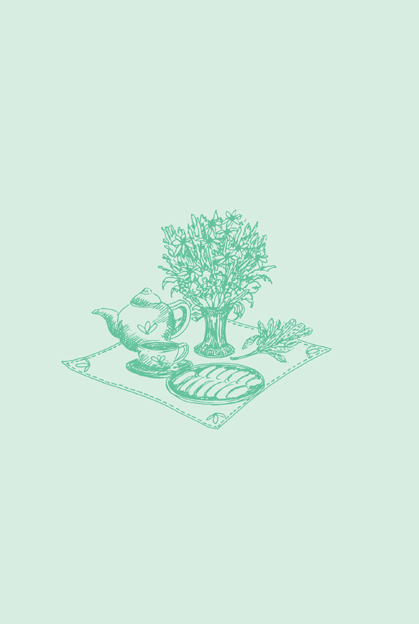

IN HIS MOST FAMOUS PRAYER,Canticle of the Creatures, St. Francis of Assisi praises God for all creation, including Sister Earth, who produces all sorts of fruit and colored flowers and herbs. I had always been exposed to flowers, fruits, and vegetables because of our family business, but herbs came into my life quite by chance, and what a great blessing that chance encounter has proved to be! Not a day goes by without my learning something new and exciting about these fascinating and wondrous plants. I just cant wait to get up every morning and begin another day in my world of herbs, whether I am planting, lecturing, cooking, selling, or just breathing in the fragrances of herbs in our greenhouses and gardens.
I cant say no to any invitation to talk about herbs. On hundreds of occasions I have spoken to all kinds of groupsgardeners, farmers, cooks, teachers, children, oldstersand I love it when I am asked questions about herbs at the end of these talks. Whats another hour when you love what youre talking about and having fun, too?
My discovery of herbs and their multiple purposes and joys has been one of the most important things in my life. Through herbs Ive strengthened my faith, enriched my family bonds, built a career thats rewarding to me on many levels, and struck up friendships with a host of fellow herb enthusiasts across the country. My passion for herbs has a lot to do with what I have found to be their essential, everlasting goodness. In these small, unassuming plants are found qualities and properties that can only be accounted for by some profound providential intelligence.
Thank God for herbs.
Herbs are so easy to grow, and so universal in their appeal and utility, that I believe there is room for an herb garden in everyones life. Thats the spirit in which this book has been conceived. Our approach to herb gardening is based on a broad understanding of the cultivation and care of herbal plants in a wide variety of landscapes great and small. It is designed to permit gardeners, from novices to experts, to enjoy herbs according to their own tastes and needs, and the particular time and space available to them.
The secret to success in growing herbs lies in the techniques of plant culture we at Gilberties Herb Gardens have developed over four generations in the business. Today, we grow nearly 500 varieties of herbs, including subspecies, and although culinary herbs account for 85 percent of our volume, about one-third of our customers also purchase and grow herbs for use beyond the kitchen. As one of the largest wholesale growers of potted herb plants in the country, we have a big picture of the ever-growing, ever-changing consumer demand for herbs. At the same time, through our busy retail garden center in Westport, Connecticut, we have come to know the down-to-earth wants and needs of home gardeners of every stripe.
Dispensing advice on growing and maintaining plants of any kind is akin to a fine art, and over the years we have learned the value of clarity and precision in giving instructions. This book sets out to achieve the same objectives for our readers as weve achieved in our gardener-to-gardener conversations with our customers.
Our first step will be to describe the optimum location and soil conditions for the basic herb garden. Then we will offer detailed profiles of the fifteen most popular culinary herbs, emphasizing the nuts-and-bolts methods for sowing and growing them most effectively. By becoming familiar with each of the basic herbs, you will learn the growing techniques that work for virtually all herbs.
In other words, once we have helped you figure out how to successfully grow parsley, which is a biennial, for use in your salads and sauces and as a garnish, then you automatically know how to grow caraway, also a biennial, for your rye-bread-baking projects, or watercress, for its tangy bite in sandwiches, salads, and soups. If you understand how to propagate and care for sage or rosemary, then you can use the same techniques on lavender, a similar single-stemmed perennial. Annual herbs, such as basil, coriander, and dillplants that, for all practical purposes, live for only the duration of a single seasonalso call for growing methods special to this category.
Once we have our cultural information in place, we will offer plans for dozens of herb gardens of broad interest, so as to acquaint you with the wide range of growth patterns among herbs, as well as their nearly infinite variety of leaf shapes and flower colors, and possibly inspire you to venture beyond the confines of the basic kitchen herb garden. The majority of these plans will be presented in an 8 x 8 planting scheme, to provide a common standard that all readers can consult in developing gardens for their own special sites.
There is no rule stating that herb gardens must be laid out in formal patterns, so as long as the right cultural conditions are present, the plants themselves will not suffer, even if the garden looks as if it were designed by a gardener wearing a blindfold. Generally, formal gardens laid out in geometric forms require more care than the rough-and-ready garden plot. But dont automatically reject the idea of a formal garden plan or associate it with pretense and privilege. The fact is, gardens organized with semicircular beds and crisscrossing pathways create as much perimeter as possible, not only for aesthetic effect but also to enable the gardener to tend and harvest herbs more conveniently.





